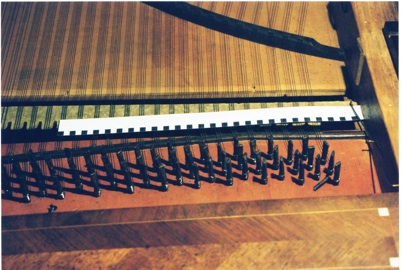During the past twenty-five years I have examined, measured and played many original fortepianos. No matter how complete and representative a published drawing of an instrument may be, very often important data - like the thickness of the soundboard - are missing. Seeing the original instruments with your own eyes and actually playing on them is of great importance to me. One such unforgettable experience would be playing the three 5-octave Walters, the 1805 Nannette Streicher and the 1828 Graf at the Germanisches Nationalmuseum in Nürnberg. It is amazing just how different from each other the Walters are, and how beautiful, particularly the two from the Rück collection, it is difficult to stop playing them. The Streicher is a different world: surely one of the most colourful and responsive instruments I've ever played. And the Graf: the richness and depth of the sound, the incredible long sustain of the lower notes and the experience of feeling the vibration of the instrument under your hands. All of this tells you so much more than a drawing or a recording.
I have always done my own drawings. In some cases with a lot of measurements and the help of an X-ray, in other cases, when I was restoring the instrument and had removed the soundboard, every part could be measured in great detail. In two such cases - the Graf and the Straube clavichord - I could compare the restored original and the finished copy side by side in my workshop.
Obviously I only use materials as one finds in the original pianos. This means using good quality hide glue, European walnut, maple and cherry, spruce from Bohemia –very similar in quality as the soundboard wood used by Fritz and Graf - and the highest quality 'peau de Suède' for the hammer coverings. Recently I switched to Vogel's pure iron for the strings, as I found it gave a purer sound and great tuning stability.
I spend a great deal of time on perfecting the feel and evenness of the keyboard and action. Some unrestored fortepianos still have their original keyboard cloth in good condition and these materials exert a great influence on the final response of the action and keyboard, ie. those parts which stimulate the most 'tactile' response from the player.
Although I prefer to duplicate an original in all it's details, there are some things which can be made a bit more comfortable for players coming from a modern background.The knee levers on the original five-octave Walters - if there are any - are put close together in the middle of the instrument. This makes using 'modern pedaling' somewhat difficult, especially in combination with the moderator. I generally place them further apart, as in the later instruments by Walter and Sohn. The damper lever is on the right in my replicas, and not at the left as in all the originals.
If you might insist on using 20th century fingering, I could make the sharps a bit narrower. On the early originals (c. 1780-1805) it is hardly possible to put ones finger in between the f, g and a sharps. On the other hand, the wide sharps on the originals are very comfortable to rest on.




